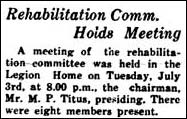A program of rehabilitation was introduced by the Department of Pensions and National Health, but was quickly taken up by the newly created Department of Veterans Affairs in October 1944. A series of press releases concerning post-war opportunities provided information for Canada's veterans. An information booklet titled, "Back to Civil Life" answered questions about life beyond the armed forces.
Discharged men or women could apply for a special payment or gratuity based on their service record. Once the amount was established and a statement was received, a veteran could apply for a re-establishment credit. It would be determined on the basis of $7.50 for each 30-day service in the Western Hemisphere and $15.00 for each 30-day service overseas. This credit was to be spent on such things as the purchase of a home, furniture, insurance, business, or tools of trade. Advisory committees were set up to assist the veterans in making plans.
The federal Department of Labour, in conjunction with provincial governments, became involved with the post-war effort by offering vocational training. L. W. Shaw was appointed as Regional Director of Rehabilitation Training for Prince Edward Island. J. T. Robison became the Veterans' Welfare Officer for the province. They arranged for representatives of their offices to visit the Summerside Legion Home in January 1945 to offer information about the programs to local veterans. Over the next few years numerous opportunities were extended for specialized training for ex-service personnel across Canada.
While the federal government was forming and carrying out its plans, the Legion branches across Canada were encouraged to form citizens' committees to consider the matter of rehabilitation. The Legion in Summerside began actively assisting veterans in their search for work in April 1944. The executive prepared a list of returned servicemen to present to the town office and local businesses. It also worked to support members in acquiring government jobs.
 The Citizens' Rehabilitation Committee for Prince County was established in June 1945. M. P. Titus was appointed chairman. At a meeting in July, the secretary was requested to order fifty copies of the first edition of the "Handbook on Rehabilitation" produced by Veterans Affairs. Those in attendance heard local returned serviceman Charles Hogan speak about his duties as newly appointed Veterans Officer in Summerside. He would be working out of a room at the Unemployment Insurance office with the task "to advise men and women seeking information on the different phases of rehabilitation."
The Citizens' Rehabilitation Committee for Prince County was established in June 1945. M. P. Titus was appointed chairman. At a meeting in July, the secretary was requested to order fifty copies of the first edition of the "Handbook on Rehabilitation" produced by Veterans Affairs. Those in attendance heard local returned serviceman Charles Hogan speak about his duties as newly appointed Veterans Officer in Summerside. He would be working out of a room at the Unemployment Insurance office with the task "to advise men and women seeking information on the different phases of rehabilitation."| Related Articles | Related Images | Related Memories | Related Websites | Inflation Calculator |
| Home Page | Site Map | Contact Us | Wyatt Heritage Properties |




